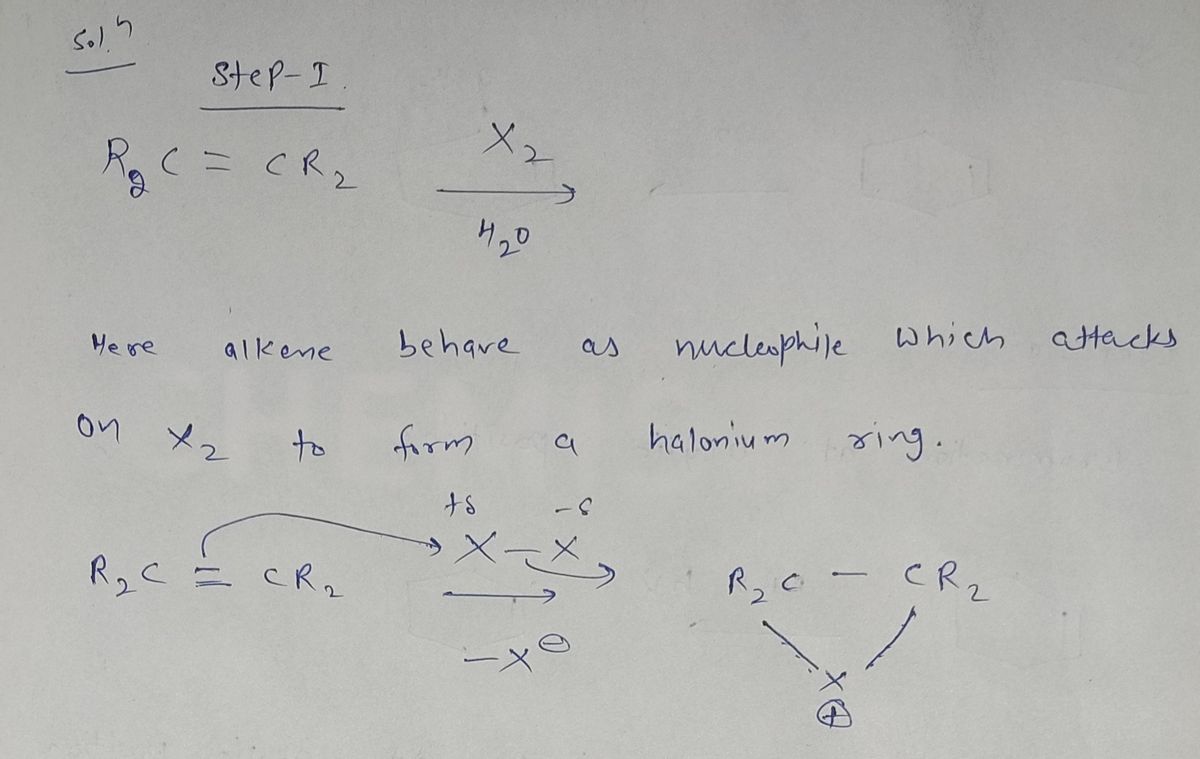Chemistry
10th Edition
ISBN:9781305957404
Author:Steven S. Zumdahl, Susan A. Zumdahl, Donald J. DeCoste
Publisher:Steven S. Zumdahl, Susan A. Zumdahl, Donald J. DeCoste
Chapter1: Chemical Foundations
Section: Chapter Questions
Problem 1RQ: Define and explain the differences between the following terms. a. law and theory b. theory and...
Related questions
Question

Transcribed Image Text:**Question 6: Give the mechanism of the following reaction.**
The image presents a chemical reaction mechanism involving the conversion of an alkene to an epoxide. The reaction proceeds as follows:
1. **Alkene:** \( R_2C\text{=}CR_2 \)
- This is the starting alkene.
2. **Intermediate Formation - Vicinal Halohydrin:**
- Reactants: \( X_2, \ H_2O \)
- Produces: \( R_2C \text{-} CR_2 \) with \( \text{HO} \) and \( \text{X} \) groups
- This product is known as a vicinal halohydrin.
3. **Epoxide Formation:**
- Reactant: \( \text{HO}^- \)
- Produces: \( R_2C \) with an epoxide ring (3-membered cyclic ether) formed by connecting two carbon atoms with an oxygen atom.
**Note:** An arrow indicates the process from alkene to vicinal halohydrin, and another from the vicinal halohydrin to the epoxide, showing the progression of the chemical reaction.
**Additional Reference:**
- See slide 13 on ether and epoxide for more detailed information on the mechanism.
*Text Note: 'reaction' and 'epoxide' are hyperlinked, indicating additional resources or slides may provide further explanation.*
Expert Solution
Step 1: Formation of halonium ring

Trending now
This is a popular solution!
Step by step
Solved in 3 steps with 3 images

Knowledge Booster
Learn more about
Need a deep-dive on the concept behind this application? Look no further. Learn more about this topic, chemistry and related others by exploring similar questions and additional content below.Recommended textbooks for you

Chemistry
Chemistry
ISBN:
9781305957404
Author:
Steven S. Zumdahl, Susan A. Zumdahl, Donald J. DeCoste
Publisher:
Cengage Learning

Chemistry
Chemistry
ISBN:
9781259911156
Author:
Raymond Chang Dr., Jason Overby Professor
Publisher:
McGraw-Hill Education

Principles of Instrumental Analysis
Chemistry
ISBN:
9781305577213
Author:
Douglas A. Skoog, F. James Holler, Stanley R. Crouch
Publisher:
Cengage Learning

Chemistry
Chemistry
ISBN:
9781305957404
Author:
Steven S. Zumdahl, Susan A. Zumdahl, Donald J. DeCoste
Publisher:
Cengage Learning

Chemistry
Chemistry
ISBN:
9781259911156
Author:
Raymond Chang Dr., Jason Overby Professor
Publisher:
McGraw-Hill Education

Principles of Instrumental Analysis
Chemistry
ISBN:
9781305577213
Author:
Douglas A. Skoog, F. James Holler, Stanley R. Crouch
Publisher:
Cengage Learning

Organic Chemistry
Chemistry
ISBN:
9780078021558
Author:
Janice Gorzynski Smith Dr.
Publisher:
McGraw-Hill Education

Chemistry: Principles and Reactions
Chemistry
ISBN:
9781305079373
Author:
William L. Masterton, Cecile N. Hurley
Publisher:
Cengage Learning

Elementary Principles of Chemical Processes, Bind…
Chemistry
ISBN:
9781118431221
Author:
Richard M. Felder, Ronald W. Rousseau, Lisa G. Bullard
Publisher:
WILEY